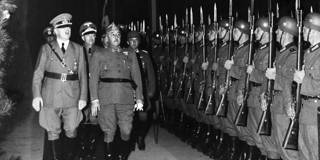Myriad political and economic factors, together with muddled leadership, eroded democratic institutions and enfeebled governments across Europe between 1918 and 1939. No one today can say how the damage wrought by former US President Donald Trump and his populist acolytes in Europe will ramify in the years ahead.
- Robert Gerwarth, November 1918: The German Revolution, Oxford University Press, 2020.
Paul Jankowski, All Against All: The Long Winter of 1933 and the Origins of the Second World War, Profile Books, 2020.
Roger Moorhouse, Poland 1939: The Outbreak of World War II, Basic Books, 2020.
Giles Tremlett, The International Brigades: Fascism, Freedom and the Spanish Civil War, Bloomsbury Publishing, 2020.
WINCHESTER, UK – Although most of the world is grateful that Donald Trump’s presidency has ended, in its wake many still feel “uncertain and afraid,” as W.H. Auden put it in his immortal poem “September 1, 1939.” Auden, drinking alone in a New York bar, viewed the day when Nazi Germany invaded Poland to initiate World War II as marking the end of a “low dishonest decade” of squalid events and increasingly squalid moral compromises. Trump’s presidency may not have lasted a decade (it only seemed to), but lump together his four-year term with the 2008 financial crisis and the COVID-19 pandemic, and the world has arguably endured an era almost as compromised as the 1930s were.

Paul Jankowski, All Against All: The Long Winter of 1933 and the Origins of the Second World War, Profile Books, 2020.
Roger Moorhouse, Poland 1939: The Outbreak of World War II, Basic Books, 2020.
Giles Tremlett, The International Brigades: Fascism, Freedom and the Spanish Civil War, Bloomsbury Publishing, 2020.
WINCHESTER, UK – Although most of the world is grateful that Donald Trump’s presidency has ended, in its wake many still feel “uncertain and afraid,” as W.H. Auden put it in his immortal poem “September 1, 1939.” Auden, drinking alone in a New York bar, viewed the day when Nazi Germany invaded Poland to initiate World War II as marking the end of a “low dishonest decade” of squalid events and increasingly squalid moral compromises. Trump’s presidency may not have lasted a decade (it only seemed to), but lump together his four-year term with the 2008 financial crisis and the COVID-19 pandemic, and the world has arguably endured an era almost as compromised as the 1930s were.